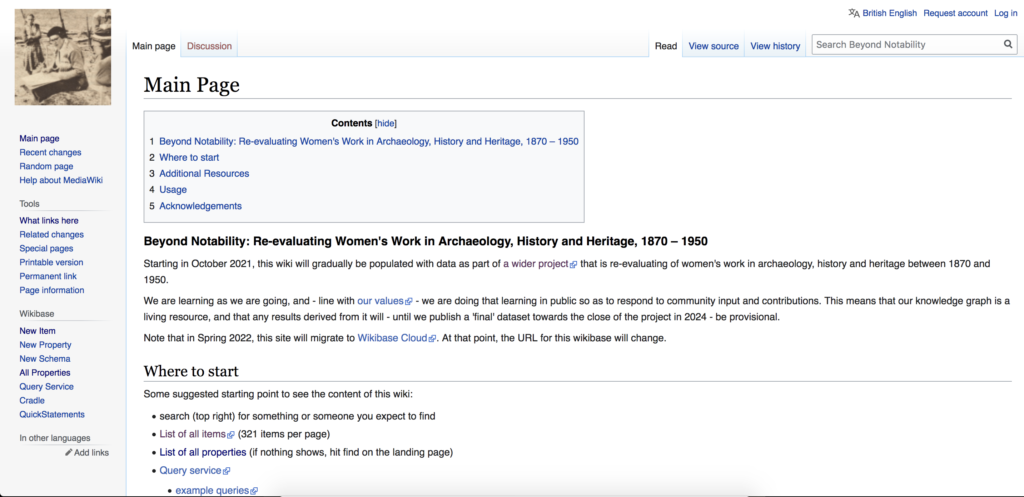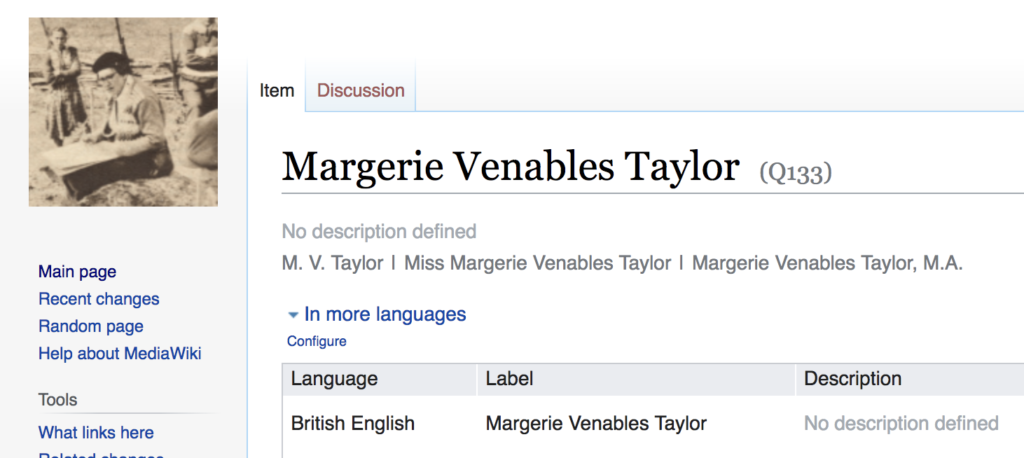We are now three months into Beyond Notability. We gave our first overview presentation of the project at the Society of Antiquaries Christmas Miscellany last month, for which we pulled together some initial findings. It’s the start of a new year, and so it seems an opportune moment to introduce the first iteration of one of the main project outputs: our research database.
The research database was set up by Co-Investigator James Baker, and currently operates on WbStack, a shared hosting platform for Wikibase sites. You can find it at the web address https://beyond-notability.wiki.opencura.com (though note the address will change in Spring 2022 when we migrate to Wikibase.Cloud, a new service that will be managed and maintained by Wikimedia Deutschland). You can also find a link to it on our website, by clicking on “Database” in the menu. This post will take you through a few key parts of the database at this early stage of its development. Please note: if you are using Chrome as your browser, you may need to make sure your language settings are set to British English in order to see all the data.
And so, to begin. At the top of the main page of the database site you will find a short description of the aims of the project. This section also links to our statement of project values, which has a related bibliography.

Below the first section you will find a section called “Where to start”. The links under this section will take you to a list of all the items (currently) in the database, each of which has an individual Q number, the unique identification number for each item. The list includes people, organisations, events, titles, publications and sources, all linked in some way to individual women’s records. You will also find a list of properties in this section. These are words or phrases that allow us to link items together, or qualify information in a given item (with, for example, an approximate date for the information given, or a reference to source material).
We have begun creating records for women who were proposed as Fellows of the Society of Antiquaries. For these entries we began by using the information available in one key source for our project, the Certificates of Candidates for Election (also known as “blue papers”). The “blue papers” have been bound into volumes, each volume representing papers from roughly a 10-year period. The volumes are held in the Society of Antiquaries’ archive. Eventually, we intend to add to these entries with information from other sources.
Scrolling down the page, under the Additional Resources section of the website you will find a link called “Meta“. This will take you to a page where we will be documenting our decision making and our source material. Under the “Item Templates” section is a list of information we will be prioritising in our dataset, and also information we intend not to prioritise. The following section “Key Sources” will link to pages with descriptions of some of the most important sources for our dataset, such as the “blue papers”, with details on why they are useful for our project.
Let’s look at an individual entry.
In 1924, the archaeologist Marjerie Venables Taylor became the first woman proposed and elected as a Fellow of the Society of Antiquaries through the same route as a man – that is to say, she was proposed by another Fellow and not by the Society’s Council. We have extracted data from the “blue paper” for M. V. Taylor (as she was more commonly known) to begin representing Taylor’s life; our current efforts are on our website at this url: https://beyond-notability.wiki.opencura.com/wiki/Item:Q133. This url will be the main ‘address’ for Taylor on our database for the present, and in due course more information from other sources will be added to supplement the information given on Taylor’s “blue paper”.

The box at the top indicates Taylor’s name as it was given on the blue paper. Alternative names are also listed under “also known as”. The alternative names are important as women frequently appear in different sources with different names (this is particularly true if they were married).
Below the top box, is the “event” of the proposal, given as a single statement. This includes the property “election to SAL proposed by“, with the name of the person who initially proposed Taylor (who we have assumed is the first signatory on the list) following. The property “evidence (free-text)” is next, enabling us to transcribe of the information on the blue paper. Another property “point in time” is used to indicate the date that the blue paper was submitted. All the people who signed her blue paper are listed with the property “proposed election to SAL signed by“. Each person has been given their own Q number, and are included in the list of “items”. The property “is elected” allows us to indicate whether or not the person was admitted as a Fellow. The property “evidence (item)” is used where we have created individual items for individual pieces of evidence, such as a job, or a publication, that were used as supporting details for admission to the Fellowship.
Below this are separate statements with properties to indicate an individual’s sex/gender, whether or not they are already included in Wikidata, whether they have been given a person ID by the Archaeology Data Service (which links to a list of their publications), their residence including locality (given in the blue paper), employment or degree information.
The information given in the blue papers can sometimes be difficult to isolate as an item. In Taylor’s case, while there was specific information about the positions she held at the Society for the Promotion of Roman Studies, there was also an explicit statement about her “distinguished service to the study of Roman Britain”. To capture this more ambiguously framed but important information, we have created a free-text property called “area of expertise“. Each of the statements described above has been given a reference, using the property “stated in“, which links to the item “Society of Antiquaries Certificates of Candidates for Election“.
There are currently three statements on Taylor’s page that do not come from her blue paper, and they show the potential for adding information from other sources to enrich the data given in the blue papers. Two of these – “described at URL” and “Archaeology Data Service person ID” – link outward to other websites that describe Taylor’s life and work in the form of statements, connecting our data to those sites, and enabling cross-referencing and querying. The third uses the property “member of” to indicated that Taylor sat on the (item) “Society of Antiquaries Research Committee“. This information has come from another recently added item, the publication “Camulodonum: The First Report of the Excavations at Colchester“. This excavation was conducted in the 1930s as a collaboration between the Society of Antiquaries (through the Research Committee) and the (item) “Colchester Excavation Committee“. Creating the publication as an item enables us to use it as a reference for the work of other women mentioned in the report. From the “Camulodonum” item, you can use “what links here” on the left-hand menu to see the other women included in the report. Some of these women were proposed and elected as Fellows in the years that followed. We will be adding their blue papers in the months to come.

We hope that this post will help you navigate our database site, which grows larger every day. This site is a work in progress, and the ways in which we are cataloguing the data will change as we continue discussing, thinking about and analysing the records. We encourage all of you to take a look at the women we’ve already been able to represent with the data available to us to date. And we hope that you enjoy engaging with the data as much as we do.